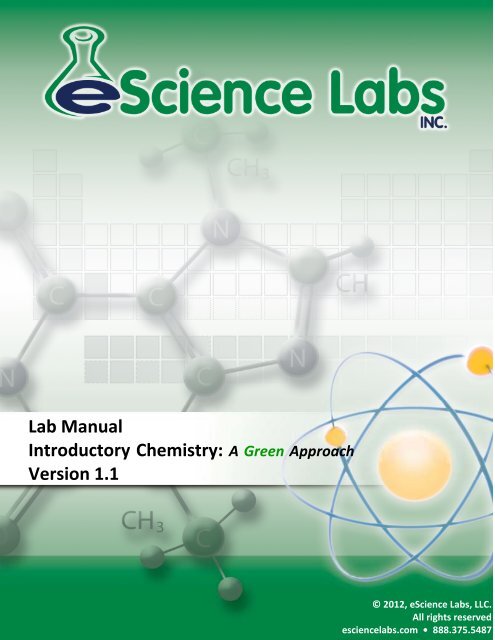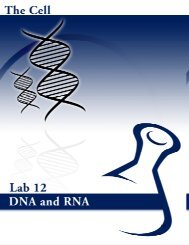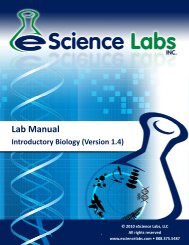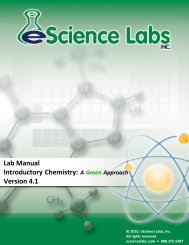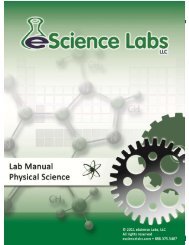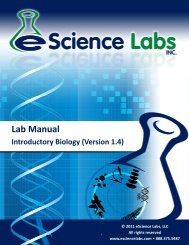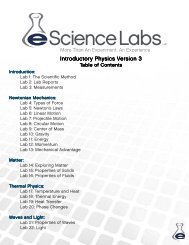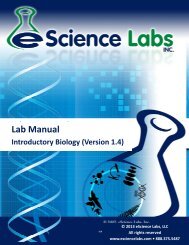Lab 12: Ionic and Covalent Bonds - eScience Labs
Lab 12: Ionic and Covalent Bonds - eScience Labs
Lab 12: Ionic and Covalent Bonds - eScience Labs
You also want an ePaper? Increase the reach of your titles
YUMPU automatically turns print PDFs into web optimized ePapers that Google loves.
<strong>Lab</strong> Manual<br />
Introductory Chemistry: A Green Approach<br />
Version 1.1<br />
© 20<strong>12</strong>, <strong>eScience</strong> <strong>Lab</strong>s, LLC.<br />
All rights reserved<br />
esciencelabs.com • 888.375.5487
Chemistry <strong>and</strong> Experiments<br />
<strong>Lab</strong> 1: Introduc�on <strong>and</strong> Safety<br />
<strong>Lab</strong> 2: The Scien�fic Method<br />
Measurements<br />
<strong>Lab</strong> 3: Measurements<br />
<strong>Lab</strong> 4: Proper�es of Ma�er - Density<br />
Ma�er <strong>and</strong> Energy<br />
<strong>Lab</strong> 5: Mixtures <strong>and</strong> Solu�ons<br />
<strong>Lab</strong> 6: Chemical <strong>and</strong> Physical Change<br />
<strong>Lab</strong> 7: Heat <strong>and</strong> Calorimetry<br />
<strong>Lab</strong> 8: Chemical Processes<br />
Atomic Theory <strong>and</strong> Structure<br />
<strong>Lab</strong> 9: Electron Configura�on<br />
<strong>Lab</strong> 10: Light Spectrum<br />
Chemical Bonding<br />
<strong>Lab</strong> 11: Molecular Models<br />
<strong>Lab</strong> <strong>12</strong>: <strong>Ionic</strong> <strong>and</strong> <strong>Covalent</strong> <strong>Bonds</strong><br />
<strong>Lab</strong> 13: Polar Bonding<br />
Table of Contents<br />
3
Introductory Chemistry<br />
<strong>Lab</strong> <strong>12</strong>:<br />
<strong>Ionic</strong> <strong>and</strong> <strong>Covalent</strong> <strong>Bonds</strong>
Concepts to explore:<br />
Introduc�on<br />
Have you ever accidentally used salt instead of sugar?<br />
Drinking tea that has been sweetened with salt or ea�ng vegetables<br />
that have been salted with sugar tastes awful! Salt <strong>and</strong> sugar<br />
may look the same, but they obviously taste very different. They<br />
are also very different chemically. Salt is made up of sodium <strong>and</strong><br />
chloride <strong>and</strong> is ionically bonded. Sugar, on the other h<strong>and</strong>, is composed<br />
of carbon, oxygen, <strong>and</strong> hydrogen <strong>and</strong> has covalent bonds.<br />
A salt (sodium-chloride) molecule is made up of one sodium atom<br />
<strong>and</strong> one chlorine atom. In order for the atoms to combine, the<br />
sodium atom must lose an electron, while the chlorine atom must<br />
gain an electron; the resul�ng ions have opposite charges <strong>and</strong><br />
a�ract one another.<br />
When sodium loses an electron it becomes a posi�vely charged<br />
ion (Na + ), called a ca�on.<br />
<strong>Lab</strong> <strong>12</strong>: <strong>Ionic</strong> <strong>and</strong> <strong>Covalent</strong> <strong>Bonds</strong><br />
• Underst<strong>and</strong> the differences between ionic <strong>and</strong> covalent bonding<br />
• Link ionic <strong>and</strong> covalent bonding with the physical proper�es of<br />
ma�er<br />
Figure 2: <strong>Covalent</strong> bonding diagram for methane<br />
(CH4). Note that both the carbon <strong>and</strong><br />
hydrogen atoms have full outer shells.<br />
Na → Na + + e<br />
Figure 1: In order to undergo ionic bonding, an electron<br />
must transfer between the Na <strong>and</strong> Cl atoms. This gives<br />
each atom an opposite charge, resul�ng in a�rac�on.<br />
-<br />
The chlorine atom adds this free electron, becoming a nega�vely charged<br />
anion.<br />
Cl + e - → Cl -<br />
A bond can now form between the nega�vely-charged Cl – <strong>and</strong> the posi�velycharged<br />
Na + . This type of bond is called an ionic bond. <strong>Ionic</strong> bonds typically<br />
form between one metal <strong>and</strong> one non-metal ion. The above reac�on can be<br />
wri�en as:<br />
Na + + Cl - → Na + Cl -<br />
Table sugar (sucrose) differs from salt in the bonding between its atoms. The<br />
atoms in sugar do not form ions; instead, they are held together because of<br />
shared electrons. This is an example of covalent bonding. Table sugar has a<br />
<strong>12</strong>7
<strong>Lab</strong> <strong>12</strong>: <strong>Ionic</strong> <strong>and</strong> <strong>Covalent</strong> <strong>Bonds</strong><br />
much more complex chemical structure than salt (see Figure 3). A covalent bond between one carbon atom <strong>and</strong> one hydrogen<br />
atom forms when one of the valence electrons of the carbon atom groups with one of the valence electrons of the hydrogen<br />
atom, forming an electron pair.<br />
<strong>12</strong>8<br />
Note: This is normally wri�en C-H.<br />
<strong>Ionic</strong>ally bonded compounds behave very differently from covalently bonded compounds. In the first part of this lab you will<br />
inves�gate how ionically bonded <strong>and</strong> covalently bonded substances behave differently in their conduc�on of electricity. You<br />
will do this by using a simple anodizing apparatus that uses a stainless steel screw <strong>and</strong> an iron nail as electrodes. In an anodizing<br />
apparatus the water between the electrodes must contain enough ions to conduct electricity. As this happens, the water<br />
will react to form hydrogen <strong>and</strong> oxygen gases.<br />
2H2O → 2H2 + O2<br />
In the second part of this lab you will explore the differences in mel�ng points between ionically bonded <strong>and</strong> covalently bonded<br />
compounds.<br />
Figure 3: Chemical structure for table sugar (sucrose). Here, different atoms combine via<br />
covalent bonding, as opposed to ionic bonding. No�ce the complexity of this molecule<br />
compared to NaCl.
Pre-lab Ques�ons<br />
1. What is an ionic bond?<br />
2. What is a covalent bond?<br />
<strong>Lab</strong> <strong>12</strong>: <strong>Ionic</strong> <strong>and</strong> <strong>Covalent</strong> <strong>Bonds</strong><br />
3. Do you think sugar or salt will melt at a higher temperature? Explain your answer.<br />
<strong>12</strong>9
<strong>Lab</strong> <strong>12</strong>: <strong>Ionic</strong> <strong>and</strong> <strong>Covalent</strong> <strong>Bonds</strong><br />
Experiment: Sugar or Salt?<br />
Stainless steel is not very reac�ve, while iron will react with oxygen to form iron oxide, commonly called rust. You will use this<br />
fact to help determine how well dissolved sugar <strong>and</strong> salt conduct electricity.<br />
The mel�ng points of sugar <strong>and</strong> salt can be tested by placing a small amount of substance in a test tube <strong>and</strong> hea�ng it at different<br />
heights over a burner or lighter flame. These experiments will help you draw comparisons between ionically <strong>and</strong> covalently<br />
bonded materials.<br />
Procedure<br />
Part 1: Nail Test for <strong>Ionic</strong> Bonding<br />
130<br />
Materials<br />
Safety Equipment: Safety goggles,<br />
gloves<br />
2 Sugar packets<br />
Test tube clamp<br />
2 Salt packets<br />
Test tube rack<br />
9-Volt ba�ery<br />
S�r rod<br />
2 Rubber b<strong>and</strong>s<br />
Butane lighter<br />
Iron nail (uncoated)<br />
Tea light c<strong>and</strong>le<br />
Stainless steel screw<br />
Spatula<br />
Wire leads with alligator clips on<br />
each end<br />
Permanent marker<br />
250 mL Beaker<br />
Ruler<br />
2 Test tubes<br />
*Dis�lled water<br />
*You must provide<br />
1. Rinse a clean 250 mL beaker several �mes with dis�lled water to prevent contamina�on from ions that may<br />
be on the beaker. Fill the beaker about ¾ full with dis�lled water.<br />
2. Pour a packet of sugar (about 3 g) into the 250 mL beaker. S�r the solu�on with a clean s�rring rod un�l the<br />
sugar is dissolved <strong>and</strong> the solu�on is well mixed.<br />
3. Stretch two rubber b<strong>and</strong>s around the 250 mL beaker. Be careful not to spill any of the solu�on. The rubber<br />
b<strong>and</strong>s should loop from the top to the bo�om of the beaker. Posi�on the 2 rubber b<strong>and</strong>s next to each other<br />
(Figure 4). HINT: Do not posi�on the b<strong>and</strong>s around the circumference of the beaker.<br />
4. A�ach the first wire lead to just underneath the flat head of an iron nail (using the alligator clip). Place the<br />
iron nail between the 2 rubber b<strong>and</strong>s on one side of the 250 mL beaker so that it is suspended in the water.<br />
The end of the nail should be in the solu�on while the head with clip is res�ng on the rubber b<strong>and</strong>s. (See Figure<br />
4).
Part 2: Mel�ng Points<br />
<strong>Lab</strong> <strong>12</strong>: <strong>Ionic</strong> <strong>and</strong> <strong>Covalent</strong> <strong>Bonds</strong><br />
5. A�ach the second wire to just below the head of the stainless steel screw. Place the screw between the 2<br />
rubber b<strong>and</strong>s on the opposite side of the 250 mL beaker, next to the nail. Make sure the end of the screw is<br />
in the solu�on <strong>and</strong> the head with the clip is res�ng on the rubber b<strong>and</strong>s.<br />
6. Connect the wire coming from the iron nail to the posi�ve (+) terminal of the 9-volt ba�ery (usually the circular<br />
terminal). CAUTION: Be careful when using energy sources such as ba�eries around water.<br />
7. Connect the wire coming from the steel screw to the nega�ve (-) terminal of the ba�ery (usually the hexagonal<br />
terminal). CAUTION: Be careful when using energy such as ba�eries around water.<br />
8. Allow the apparatus to st<strong>and</strong> for two minutes <strong>and</strong> make observa�ons. Record your observa�ons in Part 1 of<br />
the Data sec�on.<br />
9. Thoroughly clean the glassware, nail <strong>and</strong> screw with dis�lled water.<br />
10. Repeat the procedure using a salt packet (approximately 0.65 g) instead of a sugar packet.<br />
_<br />
+<br />
Iron Nail<br />
Figure 4: Apparatus for Procedure Part 1<br />
Steel Screw<br />
1. Place a spatula �p full of sugar into a test tube. The sugar should just coat the bo�om of the test tube. CAU-<br />
TION: Be sure the test tube does not have any small cracks or chips in it.<br />
2. Light the c<strong>and</strong>le using the butane lighter. CAUTION: Long hair should be �ed up <strong>and</strong> loose clothing restrained<br />
when around an open flame to prevent fire <strong>and</strong> burns. Be sure you are wearing your safety goggles.<br />
3. Place the test tube containing the sugar in a test tube holder. Hold the test tube at a slight angle over the<br />
c<strong>and</strong>le flame. Posi�on the test tube so that it contacts the blue inner core of the flame.<br />
4. Con�nue to hold the test tube in the flame un�l the sugar just begins to melt. HINT: If you keep the sugar in<br />
the flame un�l it turns dark brown or black, you will not be able to clean the test tube. Stop hea�ng test<br />
tube as soon as it begins to melt. Ex�nguish the c<strong>and</strong>le.<br />
131
<strong>Lab</strong> <strong>12</strong>: <strong>Ionic</strong> <strong>and</strong> <strong>Covalent</strong> <strong>Bonds</strong><br />
Data<br />
132<br />
5. Allow the test tube to cool to room temperature before touching it. CAUTION: The test tube will be very<br />
hot <strong>and</strong> can burn your skin if touched before it cools. Hint: A�er the test tube has cooled for a few seconds,<br />
place it in the test tube rack to finish cooling <strong>and</strong> con�nue with the procedure.<br />
6. Record your observa�ons in the Data sec�on.<br />
7. Repeat the procedure using salt instead of the sugar.<br />
8. Make sure the test tubes have cooled to room temperature before touching them. CAUTION: The test tube<br />
will be very hot <strong>and</strong> can burn your skin if touched before it cools.<br />
9. Record your observa�ons in the Data sec�on.<br />
10. Clean-up: The sugar <strong>and</strong> salt solu�ons can be poured down the drain. Rinse the beaker, screw, nail, <strong>and</strong> s�rring<br />
rod several �mes with dis�lled water. Clean the test tubes with water first <strong>and</strong> then rinse them with<br />
dis�lled water. They may need to soak for a few minutes in hot water in order to remove the melted sub-<br />
Observa�ons for the sugar solu�on:<br />
Observa�ons for the salt solu�on:<br />
Observa�ons for the mel�ng of sugar:<br />
Observa�ons for the mel�ng of salt:<br />
Part 1<br />
Part 2
Post-lab Ques�ons<br />
<strong>Lab</strong> <strong>12</strong>: <strong>Ionic</strong> <strong>and</strong> <strong>Covalent</strong> <strong>Bonds</strong><br />
1. Why is dis�lled water instead of tap water used in Part 1?<br />
2. In Part 1, why did you not observe a stream of bubbles coming off the stainless steel screw in the sugar solu-<br />
�on?<br />
3. Did any bubbles form off the screw in the sugar solu�on at all? Why might this happen, despite your answer to<br />
Ques�on 2?<br />
133
<strong>Lab</strong> <strong>12</strong>: <strong>Ionic</strong> <strong>and</strong> <strong>Covalent</strong> <strong>Bonds</strong><br />
134<br />
4. In Part 1, why did you observe a stream of bubbles coming off the steel screw in the salt solu�on?<br />
5. Explain any changes that took place on the nail.<br />
6. In Part 2, which of the substances has the lower mel�ng point? Was this what you expected? Explain your<br />
results.
1500 West Hampden Avenue Suite 5<br />
Sheridan, CO 80110<br />
303-741-0674 ⋅ 888-ESL-KITS


